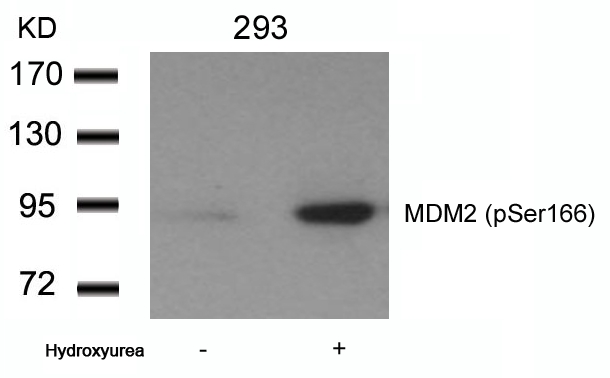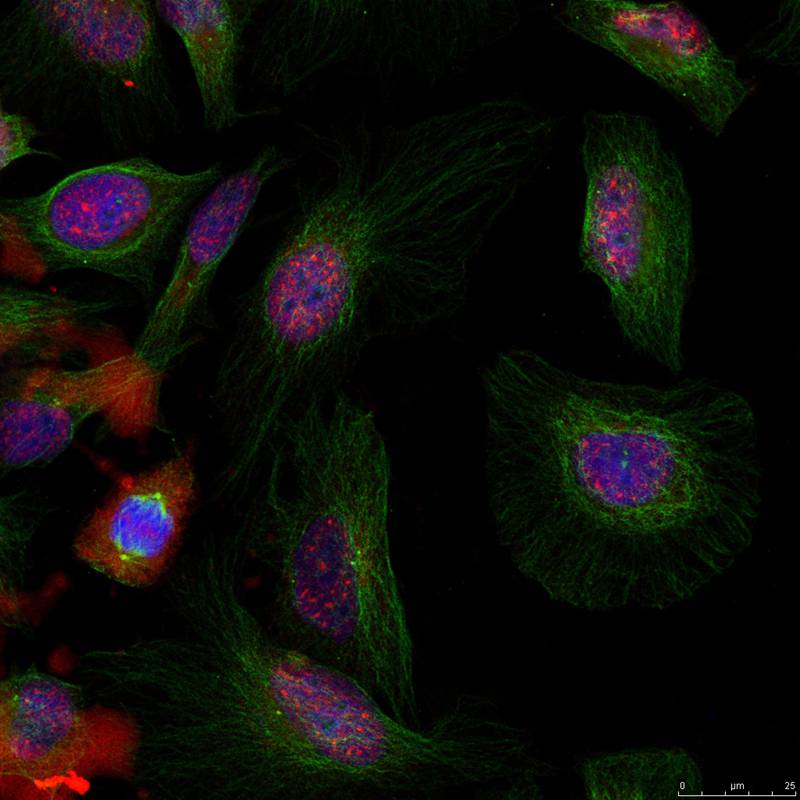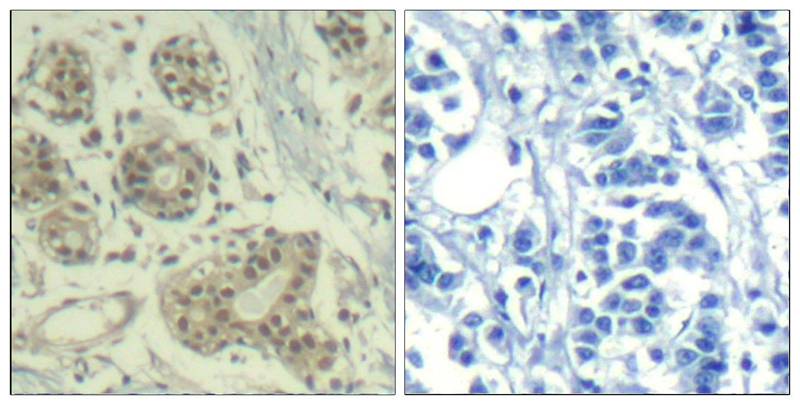


| WB | 咨询技术 | Human,Mouse,Rat |
| IF | 咨询技术 | Human,Mouse,Rat |
| IHC | 1/50-1/100 | Human,Mouse,Rat |
| ICC | 1/100-1/200 | Human,Mouse,Rat |
| FCM | 咨询技术 | Human,Mouse,Rat |
| Elisa | 咨询技术 | Human,Mouse,Rat |
| Aliases | HDMX, hdm2 |
| Entrez GeneID | 4193; |
| WB Predicted band size | 90kDa |
| Host/Isotype | Rabbit IgG |
| Antibody Type | Primary antibody |
| Storage | Store at 4°C short term. Aliquot and store at -20°C long term. Avoid freeze/thaw cycles. |
| Species Reactivity | Human |
| Immunogen | Peptide sequence around phosphorylation site of Serine 166 (A-I-S(p)-E-T) derived from Human MDM2. |
| Formulation | Purified antibody in PBS with 0.05% sodium azide. |
+ +
以下是关于MDM2(phospho-Ser166)抗体的3篇代表性文献(基于公开研究内容整理):
1. **文献名称**:*Phosphorylation of MDM2 by Akt promotes its nuclear localization and enhances cell survival*
**作者**:Cheng, Q. et al.
**摘要**:研究证明AKT激酶介导的MDM2 Ser166磷酸化促进其核转位,抑制p53活性,增强肿瘤细胞在应激条件下的存活,实验中通过特异性抗体验证了磷酸化修饰位点。
2. **文献名称**:*ATM-dependent phosphorylation of Mdm2 on serine 395: Role in p53 activation by DNA damage*
**作者**:Maya, R. et al.
**摘要**:发现DNA损伤后ATM激酶磷酸化MDM2 Ser395位点(邻近Ser166),抑制其核输出并降低自泛素化活性,从而稳定p53.研究中利用磷酸化抗体检测MDM2修饰的动态变化。
3. **文献名称**:*Regulation of MDM2 stability by the ubiquitin ligase COP1*
**作者**:Sionov, R.V. et al.
**摘要**:揭示CDK5激酶磷酸化MDM2 Ser166位点可拮抗COP1介导的MDM2降解,延长MDM2半衰期并促进肿瘤发生,实验通过磷酸化特异性抗体分析该位点的修饰水平。
**注**:以上文献信息基于领域内经典研究概括,具体实验细节建议通过PubMed或期刊数据库以标题/作者名检索原文。
The MDM2 (phospho-Ser166) antibody is a specialized tool used to detect the phosphorylated form of MDM2 (Mouse Double Minute 2 Homolog) at serine residue 166. MDM2 is an E3 ubiquitin ligase that plays a critical role in regulating the tumor suppressor protein p53. Under normal conditions, MDM2 binds to p53. promoting its ubiquitination and proteasomal degradation, thereby maintaining low p53 levels. However, phosphorylation at specific residues, such as Ser166. modulates MDM2's activity, stability, and subcellular localization.
Phosphorylation of MDM2 at Ser166 is associated with enhanced nuclear export, reduced self-ubiquitination, and increased stability, which promotes p53 degradation and suppresses its tumor-suppressive functions. This post-translational modification is often mediated by kinases like AKT or CDK4 in response to growth signals or stress, linking it to oncogenic pathways. Elevated phosphorylation at Ser166 has been observed in various cancers, including breast, lung, and prostate cancers, and is correlated with tumor progression and therapy resistance.
The MDM2 (phospho-Ser166) antibody is widely used in research to study MDM2-p53 regulatory mechanisms, DNA damage responses, and cancer biology. It enables detection of endogenous phosphorylated MDM2 via techniques like Western blotting, immunohistochemistry, or immunofluorescence. This antibody is particularly valuable for investigating therapeutic strategies targeting the MDM2-p53 axis or kinase-driven phosphorylation events in oncology and drug development studies.
×